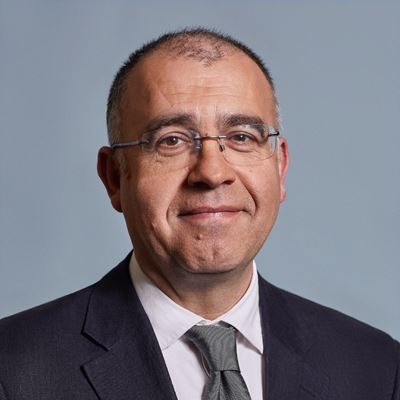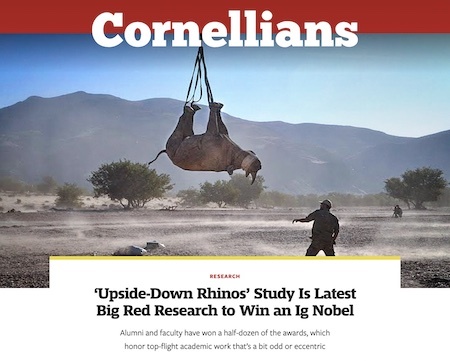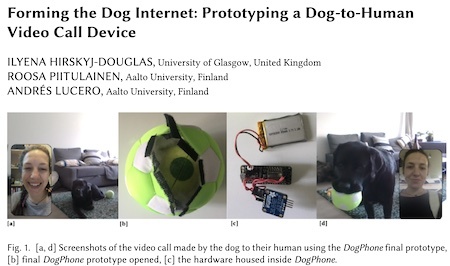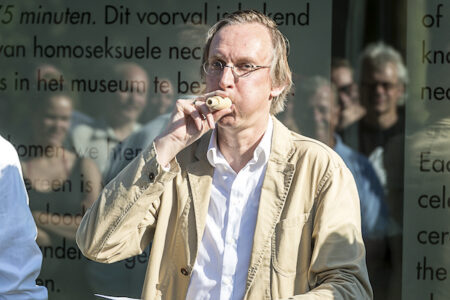Marc Abrahams's Blog, page 66
November 25, 2021
“Why do I always spill my coffee?”
Oxford maths PhD student Sophie Abrahams explicates the Ig Nobel Prize-winning research on what happens when one walks backwards while (or whilst) holding a cup of coffee.
The 2017 Ig Nobel Prize for fluid dynamics was awarded to Jiwon (Jessie) Han, for studying the dynamics of liquid-sloshing, to learn what happens when a person walks backwards while carrying a cup of coffee.
He documented that research, in the study “A Study on the Coffee Spilling Phenomena in the Low Impulse Regime,” Jiwon Han, Achievements in the Life Sciences, vol. 10, no. 1, 2016, pp. 87-101. Here you see him demonstrate that the basic physics of walking with a cup of coffee, back in 2015 while he was a high school student:
All of this was inspired by an earlier Ig Nobel Prize.
The 2021 Ig Nobel Prize for fluid dynamics was awarded to Rouslan Krechetnikov and Hans Mayer for studying the dynamics of liquid-sloshing, to learn what happens when a person walks while carrying a cup of coffee.
REFERENCE: “Walking With Coffee: Why Does It Spill?” Hans C. Mayer and Rouslan Krechetnikov, Physical Review E, vol. 85, 2012.
November 24, 2021
Podcast Episode #1085: “Mindful Dishwashing”
Marc Abrahams shows an unfamiliar research study to psycholinguist Jean Berko Gleason. Dramatic readings and reactions ensue. The study is:
“Washing Dishes to Wash the Dishes: Brief Instruction in an Informal Mindfulness Practice,” Adam W. Hanley, Alia R. Warner, Vincent M. Dehili, Angela I. Canto, and Eric L. Garland, Mindfulness, October 2015, vol. 6, no. 5, pp 1095-1103.
November 23, 2021
Kristina Collins joins Luxuriant Flowing Hair Club for Scientists (LFHfC)
Kristina Collins has joined the The Luxuriant Flowing Hair Club for Scientists (LFHCfS). She says:
(LFHCfS). She says:
I am a PhD candidate in electrical engineering at Case Western Reserve University, where I specialize in professional amateur radio and its application to ionospheric physics. I organize citizen science campaigns, usually during solar eclipses, in which people throw signals at the ionosphere and some of the signals bounce off of it, become all scrunched up, and land in other people’s radios. My masters work, also at CWRU, was on space laser robots for NASA and featured an entire chapter about LEGO. In my copious free time, I can be found looking for hair ties or messing about in boats.
Kristina Collins, MA, LFHCfS
Graduate Student, Electrical Engineering
Case Western Reserve University,
Cleveland, Ohio, USA

November 22, 2021
Air Flow In Trained Opera Singers
The airflow from a trained opera singer has been studied intensively. It led to this video, a year ago, and now to a published study (and a new video, too).
The study is “Tracking the Air Exhaled by an Opera Singer,” Philippe Bourrianne, Paul R. Kaneelil, Manouk Abkarian, and Howard A. Stone, Physical Review Fluids, vol. 6, no. 110503, 2021.
The researchers, at Princeton University and the University of Montpellier, report:
“We observed the air exhaled by a mezzosoprano singer during her performance of an Armenian lullaby “Oror.” We use a high-speed infrared camera (FLIR X6900SC) operating in the midwave range of the infrared spectrum (1.5–5 μm). The use of a filter in the absorption range of CO2 (4.2 μm) enables tracking the warm exhaled CO2. The opera singer sat beside a dark nonreflective curtain that provided a uniform background at the ambient temperature. As seen in the image sequence of Fig. 1, the infrared imaging captures the warm face of the singer and the warm exhaled CO2. The spatial extent of the exhaled CO2 can, thus, be estimated.”
There is an accompanying new video.
Canine Co-leadership Actorhood in Organizations [dog study]
“Dogs are mostly ignored by organization theory despite the existence of a rich literature on human–animal studies that helps theoretical extension in the direction of organization studies.”
 Professor Miguel Pina e Cunha [pictured] along with colleagues Arménio Rego and Iain Munro show : “why and to what extent dogs are important actors in the lives of organizations and discuss reasons that explain such relevance in functional and symbolic terms” in the journal Human Relations, Volume: 72 issue: 4, page(s): 778-800.
Professor Miguel Pina e Cunha [pictured] along with colleagues Arménio Rego and Iain Munro show : “why and to what extent dogs are important actors in the lives of organizations and discuss reasons that explain such relevance in functional and symbolic terms” in the journal Human Relations, Volume: 72 issue: 4, page(s): 778-800.
“ In organizations, dogs are engaged in power plays and in the institutional functioning of organizations, gaining symbolic power and even co-leadership actorhood.”
A full copy of the paper may be found here.
BONUS If you’d like to view, appraise, or commission oil paintings of dogs in uniforms you could try Fabulous Masterpieces (London) which asks “Why is having your dog painted in uniform so in demand these days?”
Research research by Martin Gardiner
November 21, 2021
Listen to Your Tempura
Fluid dynamics research useful in daily life:
The researchers who did the research: Akihito Kiyama, Utah State University Rafsan Rabbi, Utah State University Zhao Pan, University of Waterloo Som Dutta, Utah State University John Allen, University of Hawaii Manoa Tadd Truscott, King Abdullah University of Science and Technology.
(Thanks to Patricia Yang for bringing this to our attention.)
November 17, 2021
Upside-down Rhinos, and other Cornellian Ig Nobel Prize winners
Cornellians, the alumni magazine of Cornell University, celebrates some of the alumni who have been awarded Ig Nobel Prizes. The 2021 Ig Nobel Transportation Prize winners are just the latest:
“When you see a rhino hanging upside down, it’s a little bit comical,” he admits. “But it makes you wonder, and then you start to think—and I’m glad that it’s making people think, because our research is actually serious. Rhinos are highly endangered.”
Wait: upside-down rhinoceri?
Radcliffe and three colleagues (Vet College faculty Julia Felippe, PhD ’02, and Robin Gleed, and statistician Stephen Parry) won a 2021 Ig Nobel for their work in Namibia on methods of relocating black rhinos—which is often vital to protect the critically endangered species from poachers…..
November 16, 2021
Dog-Human Tennis-Ball-Based Internet Communicator
The quest to more often communicate with one’s dog, if one has a dog, takes a big bounce forward with the invention of a tennis-ball-based dog-to-human internet communication system. A new study offers detail on how, and how well, it works:
“Forming the Dog Internet: Prototyping a Dog-to-Human Video Call Device,” Ilyena Hirskyj-Douglas, Roosa Piitulainen, and Andrés Lucero, Proceedings of the ACM on Human-Computer Interaction, vol. 5, no. ISS, 2021. (Thanks to Tom Whipple for bringing this to our attention.)
Lead author Hirskyi-Douglas is continuing her long line of work on this subject, a line that includes the study “On the Internet, Nobody Knows You’re a Dog… Unless You’re Another Dog.”
Table 1, in the new study, is of special interest to anyone who is interested in something special. Here is the beginning of Table 1:

Some people, and perhaps many dogs and perhaps a few cats, yearn for a grand dog-cat-human communication system.
Research on the cat-human aspect of that was honored with the 2021 Ig Nobel Prize for biology, awarded to Susanne Schötz, Robert Eklund, and Joost van de Weijer, for analyzing variations in purring, chirping, chattering, trilling, tweedling, murmuring, meowing, moaning, squeaking, hissing, yowling, howling, growling, and other modes of cat–human communication.
The Talk of ScandinaviaScandinavia appears to be, currently, the center of innovation for this kind of research. The dog/tennis-ball research was conducted primarily in Finland. The cat-human communication research was conducted primarily in Sweden. Norway and Denmark have still, each of them, to establish which kind of animal to claim as most central to their own communications research yearnings.
The Duck Guy gets yet another honor
A new honor awaits Kees Moeliker, who in 2003 was awarded the Ig Nobel Prize for biology, for documenting the first scientifically recorded case of homosexual necrophilia in the mallard duck.
Here is the official announcement of the new honor:
Kees Moeliker to receive the 54th Laurens Medal
The 54th Laurens Medal is being awarded to Kees Moeliker, biologist and director of the Natural History Museum Rotterdam. The Laurenspenning Foundation expresses its appreciation for the unremitting enthusiasm with which Moeliker draws attention to urban nature in all its manifestations – within the walls of his museum, but also in books, newspapers and magazines and on radio and television.
Biologist Kees Moeliker (9 October 1960) receives the Laurens Medal on Thursday 18 November at 5.30 pm in the Grote of Sint-Laurenskerk in Rotterdam. The celebration speech will be given by Auke-Florian Hiemstra, who, as a biologist at the Naturalis Biodiversity Center in Leiden, conducts research into urban nature (such as the use of plastic waste for nests by coots). The ceremony will be graced with performances by Anne Vegter, Conny Janssen Danst and Arie van der Krogt.
In the photo: Kees Moeliker with a duck call in 2016. Photo (c) Maarten Laupman.
November 15, 2021
Organizations and food [study]: “Overweight Organizations”
 The original meaning of the word ‘corporation’ strongly hints at the idea that a firm can be regarded, in some ways (including, on occasion, legally) as a ‘person’. Could the idea of corporality be expanded to include ‘organizations’? If so, what if they eat too much – or too little?
The original meaning of the word ‘corporation’ strongly hints at the idea that a firm can be regarded, in some ways (including, on occasion, legally) as a ‘person’. Could the idea of corporality be expanded to include ‘organizations’? If so, what if they eat too much – or too little?
Professor Miguel Pina e Cunha (now at the Nova School of Business & Economics, Portugal) and colleagues explore such things :
Organizations are like people; as they get older and more successful, they put on fat (Reis and Peña, 2001). Overweight organizations are regarded as bad and unsuccessful, thus requiring an intervention of some kind. The remedy appears to be similar to the one prescribed for individuals: dieting (downsizing), hiring a personal trainer (hiring consultants to do the dirty job of firing people), and do plenty of exercise in the gym (structural changes, removal of managerial layers). The ultimate goal for individuals and organizations alike is to achieve that seductive, slim and beautiful body (make the organization more flexible and more attractive to investors). And the risks are not dissimilar either: Taken too far or too quickly, a sliming programme can become a health hazard. Anorexic firms may experience serious problems. But food may also have other meanings in the field of organizations. Among these, is the search for the best organization.
Sauce : Manna from heaven: The exuberance of food as a topic for research in management and organization Human Relations Journal Volume: 61 issue: 7, page(s): 935-963 (a full copy of which may be found here)
Coming soon : Oganizations and dogs
Marc Abrahams's Blog
- Marc Abrahams's profile
- 14 followers






